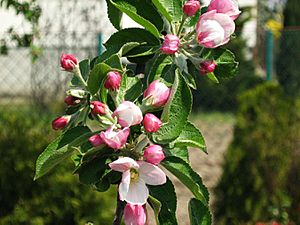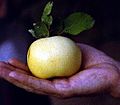Malus sieversii facts for kids
Quick facts for kids Malus sieversii |
|
|---|---|
 |
|
| Conservation status | |
| Scientific classification | |
| Genus: |
Malus
|
| Species: |
sieversii
|
| Synonyms | |
|
|
Malus sieversii is a type of wild apple tree. It grows naturally in the mountains of Central Asia, especially in southern Kazakhstan. This amazing tree is super important because scientists have found it's the main ancestor of almost all the apples we eat today (Malus domestica).
A German scientist named Carl Friedrich von Ledebour first described this tree in 1833. He called it Pyrus sieversii because its fruit looked a bit like pears. He saw them growing in the Altai Mountains.
Malus sieversii can grow in many different places. It likes warm weather and short winters. But it can also be found in the Tian Shan Mountains, where winters are long and cold. These trees grow best in the Yili valley because it has a damp climate.
This tree is a deciduous tree, meaning it loses its leaves every year. It can grow from 5 to 12 meters (about 16 to 39 feet) tall. It looks very much like the apple trees we know. Its fruit can be up to 7 centimeters (about 2.7 inches) across. This makes it the biggest fruit of any wild apple species. Unlike most apples we eat, the leaves of Malus sieversii turn red in autumn. Sadly, this special tree is now considered vulnerable to extinction.
Contents
How Malus sieversii Grows and Reproduces
Malus sieversii trees can grow new plants in a special way. They form "root suckers," which are like new shoots that grow from the roots of the main tree. These new plants are exact copies of the parent tree.
Scientists first thought these root suckers only grew if the top part of the tree was hurt. But now, they know that healthy trees also grow them. This helps the wild apples spread to new areas. For these root suckers to grow well, the soil around the roots needs to have the right amount of moisture and air. The health of the parent tree also plays a big part.
Wild apple trees have a system to stop them from fertilizing themselves. This helps keep their genes diverse. However, M. sieversii has less genetic diversity for this system compared to its close relative, Malus sylvestris. Scientists think this might be because of a big drop in their population during the Last Glacial Maximum (a very cold period in Earth's history). This caused them to live in a much smaller area, like the Yili Valley.
The Life Cycle of Wild Apple Trees
The life of a Malus sieversii tree can be split into different stages, from a tiny seed to an old tree.
- Stage 1: Young Growth
* This stage goes from when the seed sprouts to when the tree first starts to grow fruit. * A typical apple tree reaches 6 to 8 years old in this stage. * The tree grows tall and strong, and many root suckers appear.
- Stage 2: More Fruit and Growth
* Wild apple trees are usually 10 to 12 years old in this stage. * They start to produce a lot more fruit. * The tree also grows wider, with more branches.
- Stage 3: Peak Fruiting
* In this stage, wild apple trees produce the most fruit. * They are usually 25 to 30 years old. * New branches grow slower, but root suckers still help the tree grow.
- Stage 4: Old Age
* Trees in this stage are fully grown and still produce fruit. * They reach about 60 to 70 years old. * Branching slows down, and parts of the tree slowly start to die. * After 60 to 70 years, the branches dry out quickly, and the tree dies.
History and Importance of Wild Apples
Malus sieversii is very important because it's the main ancestor of the apples we eat today. Scientists have looked at the tree's shape, its molecules, and old records to figure this out. Over time, people chose Malus sieversii trees with the best fruit. They picked apples that were crispier, had more flavor, and were bigger. This is how we got the Malus domestica apples we see today.
The spread of M. sieversii and its offspring happened along the Silk Road. This was an ancient network of trade routes. In 2010, a DNA test confirmed that M. sieversii is indeed the parent of our cultivated apples. It has a lot of different genes. This makes it a great source for traits like being strong against diseases or tough in different weather.
The city of Almaty in Kazakhstan is named after the apple. "Alma" means "apple" in the Kazakh language and other similar languages. Almaty is often called "full of apples" because many Malus sieversii forests grow nearby. The old name for the city, Alma-Ata, means "Father of Apples."
Why Wild Apples Are in Danger
After the Soviet Union ended, a program that helped protect wild gardens stopped. This led to people cutting down wild apple trees in the Zailiyskiy Alatau mountains. The land where the trees once grew is now used for building houses or for animals to graze.
Also, when people plant regular apple trees near wild apple groves, the different types of apples can crossbreed. This can change the unique genes of the wild Malus sieversii trees.
New Interest in Wild Apples
Scientists are now very interested in Malus sieversii and other wild apple species. They are using them in new breeding programs. The goal is to create new apple types that can grow in tough climates. For example, they want apples that can handle very cold weather. A study in 2020 found genes in wild apples that help them go dormant and resist cold. Scientists are also looking for other good traits, like flowering late, ripening fruit early, and growing new plants easily.
The Agricultural Research Service in the United States is growing Malus sieversii. They hope to find valuable genetic information to help breed modern apple trees. Some of these wild apple trees show amazing resistance to diseases. This difference in how individual trees react to diseases shows how much more diverse their genes are compared to our domesticated apples. For example, wild apples have genes that fight against blue mold. Scientists have also found that M. sieversii seedlings can resist diseases like apple scab, fire blight, and cedar apple rust. Research in 2001 also found that wild apples can resist certain insects, like apple maggots. Studies also show that M. sieversii can handle hot, dry places and resist sunburn.
Apples with Red Flesh
Malus sieversii has recently become very important for breeding apples with red flesh inside. This is because of its wide variety of genes. These genes help improve how well cultivated apples resist drought, cold, and pests.
Some special features of M. sieversii are now being used for breeding red-fleshed apples. These include high levels of healthy plant compounds called flavonoids (like anthocyanin) and a short time before they start producing fruit. Traditional red-fleshed apples don't have as many of these flavonoids. Using M. sieversii for breeding, especially for its high anthocyanin content, has many health benefits. These include helping to prevent heart disease and protecting the liver.
A specific type of M. sieversii, called Malus sieversii f. niedzwetzkyana, is especially good for breeding red-fleshed apples. This type has red flowers, red fruit skin, and red flesh. It also has a lot of anthocyanin. Scientists found that when breeding this type, light helps produce more anthocyanin than growing them in the dark. Hybrids (mixes) of Malus sieversii are also interesting to breeders who want red-fleshed apples.
Protecting Wild Apples
Malus sieversii is a high priority for conservation in China. The International Union for the Conservation of Nature (IUCN) has listed it as vulnerable.
Human activities and natural disasters are the main reasons why the number of wild M. sieversii trees is going down. Fungi, like Phytophthora plurivora and Alternaria alternata, also harm the trees by damaging their roots. This makes the trees weaker and more likely to be attacked by other pests, like insects such as Agrilus mali, which further destroy the population.
One way to protect these trees is called ex situ conservation, or seed banking. This means collecting and storing seeds in a safe place, like a seed bank. This helps protect the genetic diversity of the trees for a long time. Seeds from Kazakhstan and the Kyrgyz Republic have been stored in the United States. Another method is in situ conservation, which means protecting the trees where they naturally grow. For example, barbed wire fences have been put up around areas with M. sieversii in Xinyuan, China. A study in 2016 showed that protecting populations in their natural habitat works well, especially at higher elevations where there is less risk from humans and insects.
Besides traditional methods, a special type of fertilizer called biofertilizer has shown good results. It helps stop harmful fungi from growing on wild apple trees. It does this by making the trees stronger against infection, helping their roots grow, and improving the soil. Recently, new methods like cloning and using plant hormones have also helped grow new wild apple populations.
In the 1800s, many wild apple trees in the mountains of Kazakhstan were cut down for wood and farming. Wild apple forests were turned into grazing land for animals. This changed the soil and hurt young seedlings and roots. Thorny bushes like eglantine and barberry, which usually help protect wild apples from animals, were also cut down. This made it even harder for wild apples to grow and weakened their root suckers, which are important for new growth.
Images for kids
See also
 In Spanish: Malus sieversii para niños
In Spanish: Malus sieversii para niños





